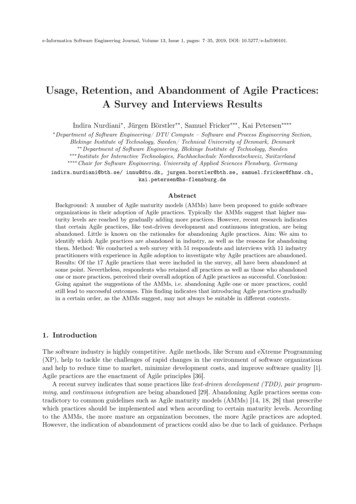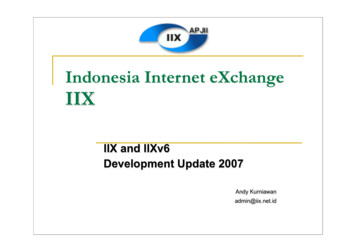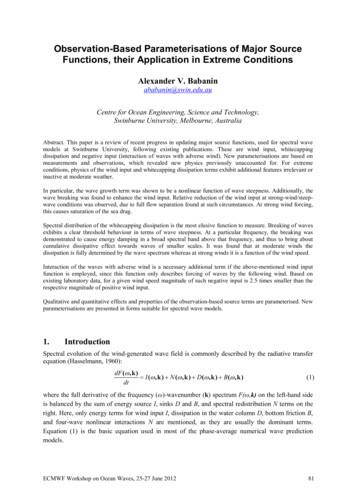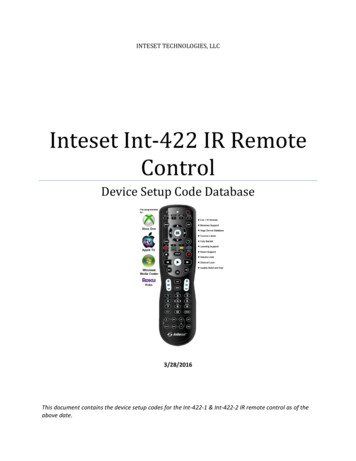
Transcription
http://www.diva-portal.orgPreprintThis is the submitted version of a paper presented at 18th International Conference onSoftware Business, (ICSOB), Essen.Citation for the original published paper:Fricker, S., Maksimov, Y. (2017)Pricing of data products in data marketplacesIn: Werder K.,Ojala A.,Holmstrom Olsson H. (ed.), Lecture Notes in BusinessInformation Processing (pp. 49-66). Springer VerlagLecture Notes in Business Information 6 4N.B. When citing this work, cite the original published paper.Permanent link to this version:http://urn.kb.se/resolve?urn urn:nbn:se:bth-15615
Pricing of Data Products in Data MarketplacesSamuel A. Fricker1,2, Yuliyan V. Maksimov11i4DsCentre for Requirements Engineering,University of Applied Sciences Northwestern Switzerland (FHNW), Windisch, Switzerland[samuel.fricker, yuliyan.maksimov]@fhnw.ch2SoftwareEngineering Research Laboratory (SERL-Sweden),Blekinge Institute of Technology, Karlskrona, Swedensamuel.fricker@bth.seAbstract. Mobile computing and the Internet of Things promises massive amounts of data forbig data analytic and machine learning. A data sharing economy is needed to make that dataavailable for companies that wish to develop smart systems and services. While digital marketsfor trading data are emerging, there is no consolidated understanding of how to price data products and thus offer data vendors incentives for sharing data. This paper uses a combined keywordsearch and snowballing approach to systematically review the literature on the pricing of dataproducts that are to be offered on marketplaces. The results give insights into the maturity andcharacter of data pricing. They enable practitioners to select a pricing approach suitable for theirsituation and researchers to extend and mature data pricing as a topic.Keywords: data pricing, data marketplace, systematic literature review.1IntroductionWith the rise of Mobile Computing and the Internet of Things, massive amounts of dataare being produced [1]. Already today, a substantial portion of the population owns asmartphone that is packed with sensors. In the near future, Internet nodes with sensingcapabilities are expected to reside in almost any everyday thing. The data, analyzedwith big data analytics and machine learning, offers an opportunity to bring aboutbreakthroughs in processing images, video, speech, and audio [2]. Data of importanceare generated by industrial vendors, private citizens, or the government [3]. Politics andexecutive floors of global businesses underline the importance of such data [4].Marketplaces are enablers for the exchange of data [5]. A data marketplace is a platform on which dataset can be offered and accessed [3]. Marketplaces enable trade byoffering services for buying and selling data, finding datasets, and obtaining access tovendors. Often cited examples are the Microsoft Azure Marketplace, Xignite, Gnip,AggData, and Cvedia. Data that are being offered may be static archives or onlinestreams of new data. Different modes of access may be offered, e.g. whole repositories,APIs for answering queries, or subscriptions. We call such variants data products.According to an early survey of data vendors, estimating the value of data and settingthe right price for a data product offering is a key challenge [6]. For vendors, the pricingadfa, p. 1, 2011. Springer-Verlag Berlin Heidelberg 2011
is part of the value-creation with data. For customers, wrong pricing makes data unattractive. While overviews of the pricing of software products exist [7], there is no consolidated overview of the state-of-the-art for pricing data products.Given the drastic changes that the software industry is undergoing at this momentwith the move towards ‘smart everything everywhere,' it is critical that a better understanding of the business with data is obtained. It is urgent that the so far young andsmall research area is being developed, especially because it has hardly been discussedin the domain of software business. The lack of consolidation limits the uptake of goodpractice by practitioners and hinders the planning of research in this area.This paper offers an overview of the current research in the pricing of data for datamarketplaces. It utilizes a systematic approach to identifying, screening, analyzing, andsynthesizing the research literature. The paper describes the research on data pricing,the contexts in which data pricing was investigated, and the maturity of the area. Forowners of data products, the results offer guidance of how to do pricing. For researchers, the results offer insights into the knowledge frontier and knowledge gaps for planning research in data pricing. We intend to utilize the results for building support fordata pricing into the Bonseyes marketplace (www.bonseyes.com).The paper is structured as follows. Section 2 gives an overview of the research methodology. Section 3 describes the results of reviewing the research literature. Section 4discusses the obtained results. Section 5 summarizes and concludes.2Research MethodologyThe study aimed at consolidating the research on the pricing of data products offeredon marketplaces. To achieve this aim, we used a systematic approach to reviewing theresearch literature. We used the following steps to conduct the review. 1) Identify andscreen the start set of primary studies with a database search. 2) Identify and screen thefinal set of primary studies with snowballing. 3) Evaluate the quality of the researchbased on full texts. 4) Extract and analyze the data for answering the research questions.We used the snowballing guidelines proposed by Wohlin [8] for paper identification.The snowballing helped us to avoid many false positives that would have been generated by a database search string that is too inclusive. For screening and research qualityevaluation, we used the guidelines provided by Kitchenham and Charters [9]. The dataextraction and analysis step followed the systematic mapping recommendations of Petersen [10]. We chose to follow Petersen because the results presented by the includedpapers did not allow any meta-analysis with quantitative statistic methods.To guide our systematic review, we asked the research questions shown in Table 1.RQ1 is intended to overview how far the state-of-the-art has advanced and where theresearch gaps are. We followed the ideas of Ivarsson and Gorschek to assess the maturity of the research with the strength of the empirical evaluation [11]. RQ2 is intendedto obtain an overview of pricing from the data vendor’s perspective. To understandpricing, we were first interested in what the products were that were priced and whichcontexts these products targeted. We then described the rules for determining prices,the pricing models, and the mechanisms used for applying these rules.
Table 1. Research questions.Research QuestionRQ1: How mature arethe researched pricingmodels?RQ2: How do vendors price data?DescriptionMaturity is a concern in technology transfer from academia to industry [11]. Maturity is important for practitioners to decide about the adoption of technology,such as pricing models, and for researchers to further mature the technology.The pricing of data is the concern being addressed by the presented research. Theanswer to this RQ should inform practitioners adopting pricing for the data theyoffer, trade, or buy and researchers that aim at improving the state-of-the-art.RQ2.1: Which conA context offers the frame for offering and exploiting technology. The contexts fortexts did the pricingthe pricing of data comprise the domains in which the data would be used, the typesmodels target?and storage of data, and scenarios for exploiting that data.RQ2.2: What kinds of A data product is the packaging of data that get a price tag attached. We expect thedata products weredefinition of the data products to consist of the price metrics (i.e. a definition ofbeing priced?what is being priced), the quality attributes that are being considered for productdefinition, and the characteristics of the market for which the product is defined.RQ2.3: What pricing A pricing model is a set of the rules established for defining prices. A pricing modelmodels weredescribes how product and context variables are considered to achieve aims of inevaluated?terest, such as profit optimization.RQ2.4: What mecha- To sell data to a customer the final price for the instance of the data product mustnisms were proposed be determined by applying a pricing model. With the answer to this RQ, we giveto determine a price? an overview of how the pricing model is used to determine a final price.2.1Research ProcessStart set of primary studies. We built the start set of papers with a keyword search forprimary studies in Scopus. Scopus was selected because it offers the largest number ofabstracts and citations in science and technology. We searched title, abstract, and keywords fields with the string “data marketplace” on January 20, 2017. The string constrained the population while leaving the intervention, comparators, outcomes, and contexts open [9]. These latter parts were used in the analysis for RQ2. We constrained thesearch to marketplace, leaving terms like databases and repositories out, because ofour interest in business with data and not warehousing. The search yielded 181 papers.We screened the papers based on title, abstract, and meta-information. FollowingKitchenham’s recommendations [9], we developed the selection criteria based on theresearch questions and practical issues. We maintained a list of excluded studies together with the reasons for exclusion. Table 2 shows the inclusion and exclusion criteriathat resulted from this process. The two authors assessed the exclusion of primary articles by seeking consensus. After screening, the start set of papers contained 11 papers.Table 2. Study selection criteria (based on the research questions* and practical reasons**).Inclusion criteria- Proposal, evaluation, and discussion of a vendor’spricing of data*.Exclusion criteria- Short papers of up to 4 pages**- Study report superseded by an ensuing report of the same study**.- Customer or market maker’s view of pricing instead of vendor’s view*.- Costing, e.g. for cost minimization of data management*.- Units of analysis other than the pricing of data, e.g. market policies*.- Analyses of data value or other variables, rather than data pricing*.
Final set of primary studies. We did backward and forward snowballing by lookingat the reference lists of the papers in the start set and by using Scopus to identify papersthat cited the papers in the start set. The backward snowballing yielded 66 additionalrelevant papers. The forward snowballing yielded 6 additional papers that cited the startset. The small number was due to the inclusion of many recent papers in the start set.We again screened the papers by studying their title and abstract and applying thesame selection criteria. After screening, the final set of papers contained 18 papers.Quality Assessment. We assessed the quality of the so far selected papers with the aimof including only those with research quality sufficient to extract data and answer ourresearch questions reliably. Table 3 shows the quality assessment criteria that we derived from Kitchenham [9] and applied to the full text. Papers with a score of less than0.6 got removed from further consideration, leaving us with 15 papers for the data extraction and analysis step.Table 3. Quality assessment criteria.QualityAssessment QuestionCriterionFulfillment How well does the reof aimssearch address its original aims?Clarity of How clear are the unbackderlying theory andgroundassumptions?Quality of How credible are thethe sample data that are used forthe research?Credibility How clear is the chainof the reof evidence?searchClarity of How clear is the linksynthesisof analysis results andthe related work to thediscussed contributionand implications?Evaluation approachScoreIdentify the aims from the abstract and introduction andcompare with the research.Evaluate the background andrelated work sections if it fitsthe performed research.Evaluate the data used forvalidating theories or models.Evaluate the match betweenthe method section, data,analysis, and analysis results.Evaluate the traceability ofthe discussion to the presented results and background literature.1.0: perfect match0.5: partial or vague match0.0: no match1.0: well-defined and strong fit0.5: partial fit0.0: unclear or not fitting1.0: representative real-world data0.5: data well described0.0: unclear what data was used1.0: clear and traceable0.5: partial chain.0.0: unclear chain of evidence.1.0: contribution and both traces clear0.5: contribution vague or only onetrace clear0.0: no discussion or unclear connection with results and related workData Extraction. To answer our research questions, we extracted data with the dataextraction form shown in Table 4. The table declares what we extracted, defines howwe abstracted the extracts, and offers details about the data extraction.Table 4. Data extraction form (*: values determined inductively)PropertyValuesRQ1: Pricing Model MaturityResearch method Formal analysis, simulation,laboratory validation, realworld validation1DescriptionThe type of research method influences the readiness ofthe researched entity. E.g., the European Horizon2020research program connects research methods1 to technology readiness data/ref/h2020/wp/2014 2015/annexes/h2020-wp1415-annex-g-trl en.pdf
PropertyDatasetValuesNo data, synthetic data, synthetic data of justified industrial size, industrial dataRQ2.1: ContextsDomainA vertical market like SmartCity, Business Administration, or Linguistics.Type of data*See column ‘Type of Data’ inTable 7.Data exploitation See column ‘Data Exploitascenario*tion Scenario’ in Table 7.DescriptionThe dataset used for
sion of a vendor’s pricing of data*. - Short papers of up to 4 pages** - Study report superseded by an ensuing report of the same study**. - Customer or market maker’s view of pricing instead of vendor’s view*. - Costing, e.g. for cost minimization of data management*.










